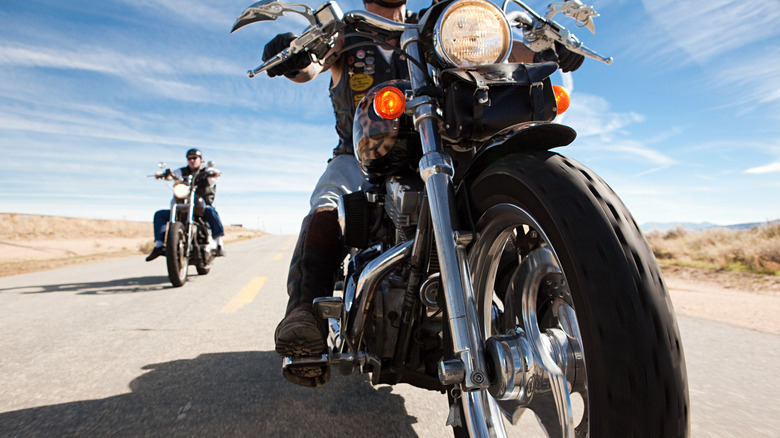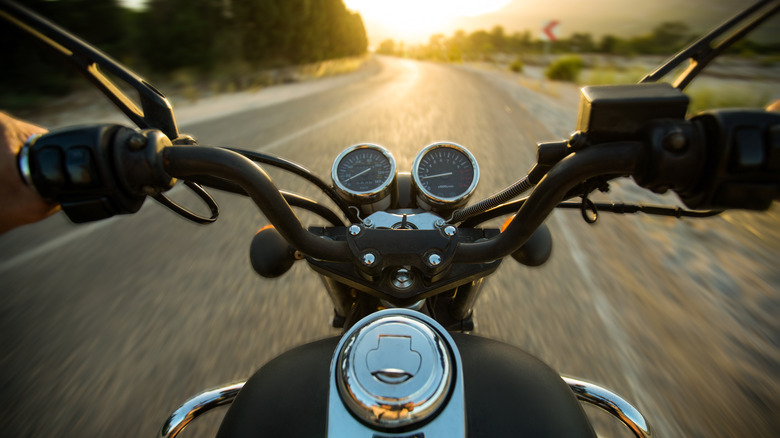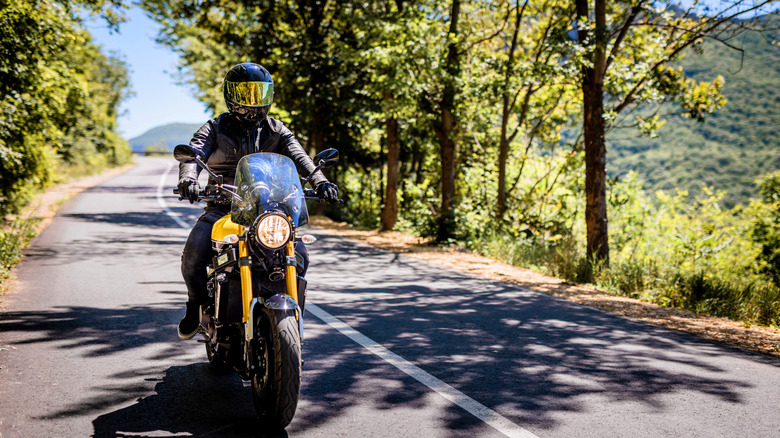What To Consider When Looking For The Safest Motorcycles To Ride
Freedom often comes to mind when people think of motorcycles. Unlike a passenger car or SUV, when you ride a bike, you're not confined to a small space. Instead, you can lean into turns and feel every twist and turn of the road beneath you. However, that freedom comes with a tradeoff — less protection and more exposure to injury in the case of an accident. Most riders are aware of these risks when they purchase their bike. They also know there are many unfounded myths circulating about motorcycles that can get in the way of them enjoying riding. Still, most riders strive to make safety a priority when riding, including wearing a helmet and using other accessories to make their rides safer.
Aside from considering what additional gear might best protect the human body, it's also important to assess how safe a motorcycle is to ride. That can be significantly influenced by your riding experience and how you plan to use your bike. Nevertheless, whether you're a veteran rider or just thinking about purchasing your first bike, knowing what safety features to look for when shopping for a motorcycle can go a long way toward keeping you safe on the road.
Design and engineering
How your bike is designed and engineered can make all the difference in your overall safety on the road. While there are important tips every new motorcycle rider should know, safety starts with the foundational design of the bike you purchase, including its build quality and features, including anti-lock brakes (ABS) and traction control. Stability is one of the first things you should consider when shopping for a bike. A motorcycle's structural design — frame, weight distribution, and center of gravity — all play a role in determining how stable it'll be on the road. Having a low center of gravity will enhance its stability, making it easier to handle at lower speeds and during sharp turns.
If you're putting safety first when looking for a motorcycle, ABS is an essential feature. According to the National Institutes of Health, ABS lowered motorcyclists' involvement in fatal crashes by 22% per 10,000 registered vehicles. The reason ABS is so effective in keeping riders safe is that it prevents wheels from locking during braking, preventing skids, and allowing drivers to maintain control during sudden stops. These brakes work in a variety of conditions and are especially effective on slippery roads where the risk of skidding or losing traction is higher. Stability control monitoring systems also play an important role, assisting with curves when traditional ABS might be ineffective.
Traction control systems are another safety feature that complements ABS. These systems work by adjusting the power output to the rear wheel, helping it maintain an adequate grip on the road. When considering safety features, it can be helpful to become familiar with the difference between traction control and stability control.
Ergonomics and fit
Your motorcycle needs to fit your body; if it doesn't, you won't feel comfortable riding it and won't be able to control it properly, compromising your safety on the road. With the right ergonomics, you'll be able to easily reach all of your bike's controls and maintain a natural, relaxed posture, which will help you maintain control and minimize your fatigue while riding. The best way to figure out if it's a good fit for you is to try it out. You'll most likely have to test different sizes and models to find one that isn't too big or small for you.
When you test the bike, think about your riding position, including your distance from the handlebars, the height of the seat, and the position of the foot pegs. You should be able to sit comfortably without straining. This is especially important during long rides when, if your bike isn't a good fit, fatigue can set in, reducing your ability to react quickly to road conditions and hazards. An ergonomically fitted motorcycle will make it easier for you to handle your bike effectively in critical situations, whether navigating through rush hour traffic or making sharp turns. The right fit will lessen the chances you'll suffer from muscle fatigue, discomfort, or pain while riding, all of which could have a negative impact on your ability to drive safely.
How much the motorcycle weighs
There's a huge range when it comes to how much a motorcycle can weigh, with the average bike weighing between 300 and 500 pounds. You'll want to pay close attention to the weight of the motorcycle you're considering because it has an impact on everything from handling to your comfort while riding. While heavy bikes have their benefits, like more power, they're often not the best choice for new or inexperienced riders. That's because the heavier a bike is, the more difficult it becomes to control.
When you need to park, make a turn, or brake, you're going to really feel a bike on the heavier end of the weight scale. This can jeopardize your safety if you're a new biker. In contrast, while a lightweight bike might not feel as secure on the open highway, it's easier to control in most situations, and fatigue won't set in as quickly. You'll be able to judge best whether a motorcycle is the right weight for you by going on a test drive. When in doubt, in most cases, it's best to err on getting a lighter motorcycle.



